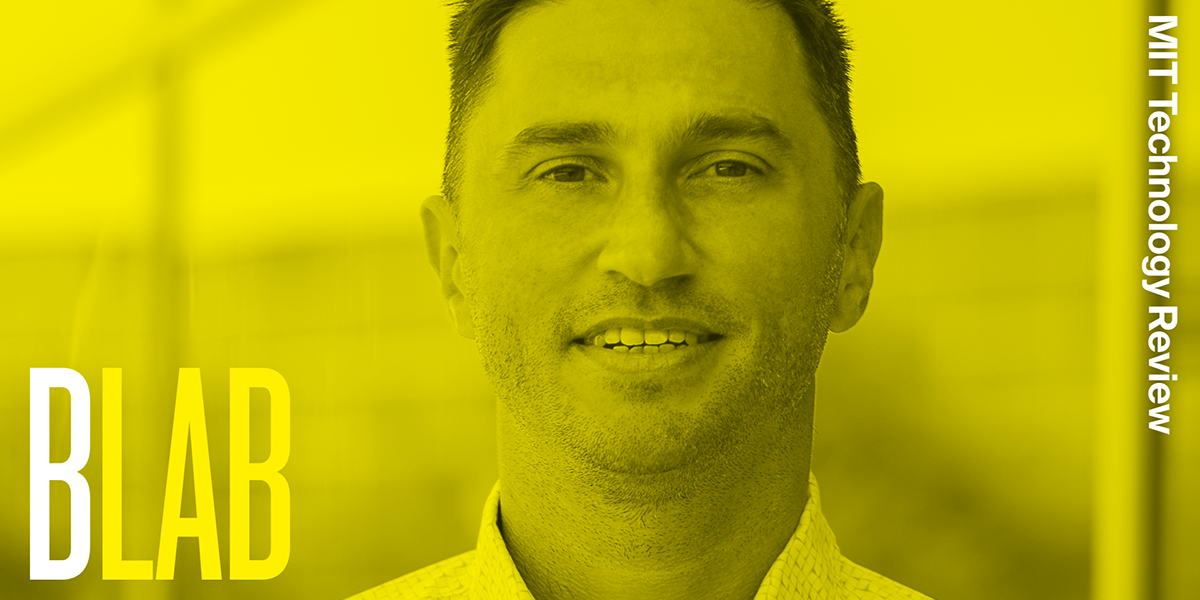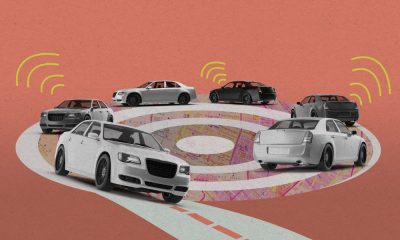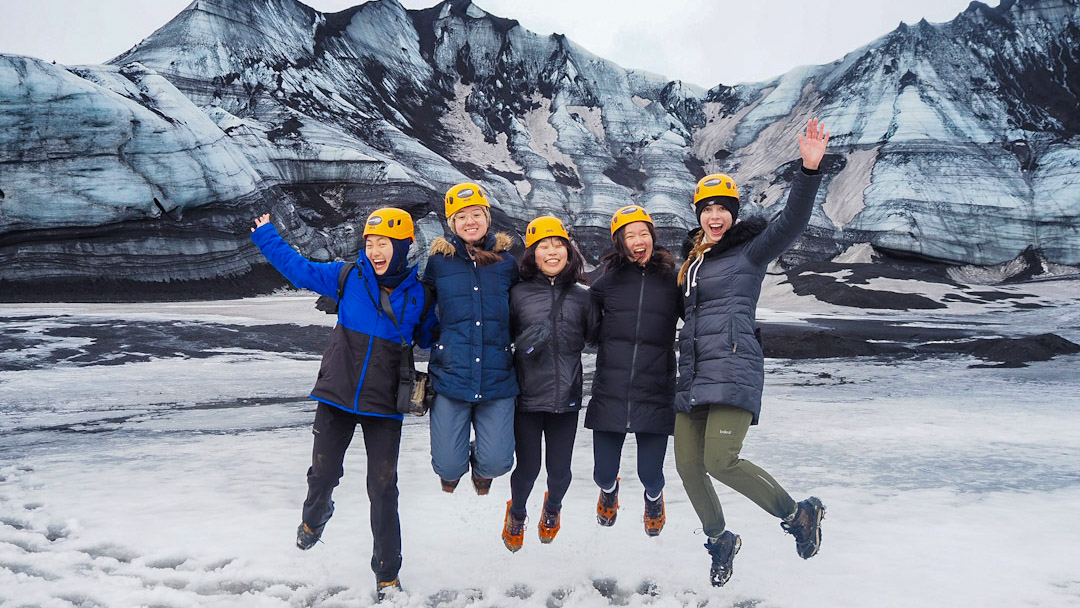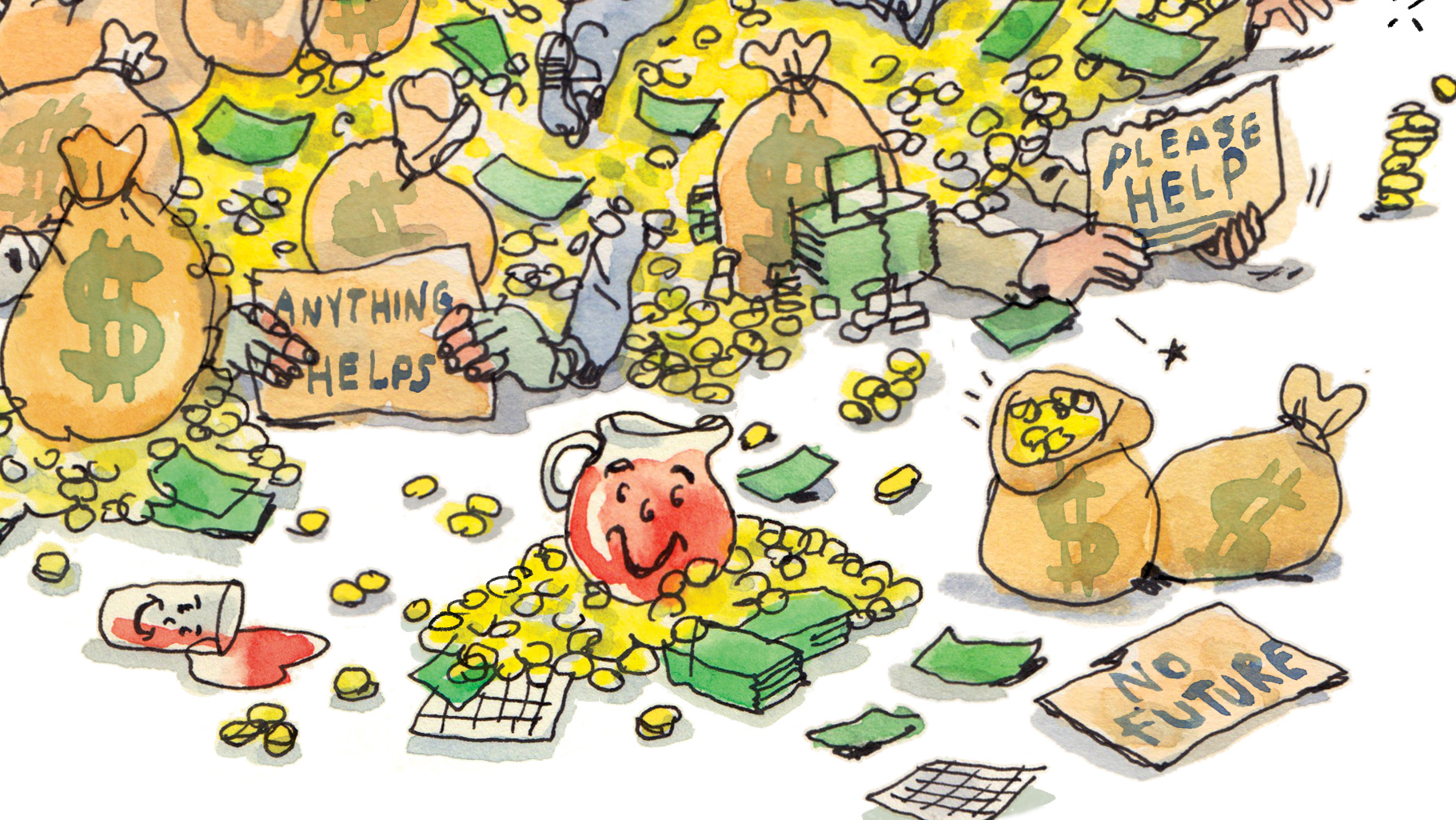Tech
Using machine learning to build maps that give smarter driving advice
Published
4 years agoon
By
Terry Power
If you drive in the United States, chances are you can’t remember the last time you bought a paper map, printed out a digital map, or even stopped to ask for directions. Thanks to Global Positioning System (GPS) and the mobile mapping apps on our smartphones and their real-time routing advice, navigation is a solved problem.
But in developing or fast-growing parts of the world, not so much. If you live in a place like Doha, Qatar, where the length of the road network has tripled over the last five years, commercial mapping services from Google, Apple, Bing, or other providers simply can’t keep up with the pace of infrastructure change.
“Each one of us who grew up in Europe or the US probably cannot understand the scale at which these cities grow,” says Rade Stanojevic, a senior scientist at the Qatar Computing Research Institute (QCRI), part of Hamad Bin Khalifa University, a Qatar Foundation university, in Doha. “Pretty much every neighborhood sees a new underpass, new overpass, new large highway being added every couple of months.”
As Qatar copes with this rapid growth—and especially as it prepares to host the FIFA World Cup in 2022—the bad routing advice and accumulating travel delays from outdated digital maps is increasingly costly. That’s why Stanojevic and colleagues at QCRI decided to try applying machine learning to the problem.
A road network can be interpreted as a giant graph in which every intersection is a node and every road is an edge, says Stanojevic, whose specialty is network economics. Road segments can have both static characteristics, such as the designated speed limit, and dynamic characteristics, such as rush-hour congestion. To see where traffic really is going—rather than where an old map says it should go—and then predict the best routes through an ever-changing maze, all a machine-learning model would need is lots of up-to-data data on both the static and dynamic factors. “Fortunately enough, modern vehicle fleets have these monitoring systems that produce quite a lot of data,” says Stanojevic.
Stanojevic is talking about taxis. His team at QCRI partnered with a Doha-based taxi company called Karwa to collect full GPS data on their vehicles’ comings and goings. They used that data to build a new mapping service called QARTA that offers routing advice to drivers at Karwa and other operators such as delivery fleets.
Stanojevic says QARTA’s deeper understanding of the actual road and traffic situation in Doha helps drivers shave tens of seconds off every trip, which translates into a fleet-wide efficiency gain of 5% to 10%. “If you’re running a fleet of 3,000 cars, 5% of that is 150 cars,” Stanojevic says. “You can basically remove 150 cars from the road and not lose any business.”
Although QCRI’s system probably can’t compete with the big map-services providers in the developed world, it could help cities in the Middle East and other developing regions manage growth more wisely, Stanojevic says. And a few years from now, as more autonomous vehicles take to the streets, machine-learning-based routing advice could look at the big picture in a busy city and help fleets cut carbon emissions by keeping drivers out of traffic jams. “By having some sort of a global view of what’s going on in the whole city, autonomous vehicles can actually reroute us to have some sort of global load balancing, to help everyone be better off.”
This podcast was produced in partnership with the Qatar Foundation.
Show notes and links
Qatar Computing Research Institute
“Traffic Routing in the Ever-Changing City of Doha,” Sofiane Abbar, Rade Stanojevic, Shadab Mustafa, and Mohamed Mokbel, Communications of the ACM, April 2021
Full Transcript
Laurel Ruma: From MIT Technology Review, I’m Laurel, and this is Business Lab, the show that helps business leaders make sense of new technologies coming out of the lab and into the marketplace.
Our topic today, better mapping for fast-growing cities. Traffic. Traffic is difficult for all of us, but with an increasing number of vehicles on the roads and congestion, apps that try to calculate the best routes cannot miraculously create shortcuts. But what happens when your country doubles in size in 10 years? New roads, new neighborhoods, new buildings: it’s time for a new map.
Two words for you: Automatic mapping.
My guest is Dr. Rade Stanojevic, who is a senior scientist at Qatar Computing Research Institute, part of Hamad Bin Khalifa University, a Qatar Foundation university. Dr. Stanojevic studies computer networks and network economics. Currently he’s using graph theory, machine learning, and other techniques to try to build more accurate models of real-world traffic in Doha, Qatar, and other cities.
Before joining QCRI, he spent time as a staff researcher at the Madrid Institute for Advanced Studies Network Institute and Telefonica I&D in Spain.
This episode of Business Lab is produced in association with the Qatar Foundation.
Welcome, Dr. Stanojevic.
Rade Stanojevic: It’s great to be with you today, Laurel. Thank you.
Laurel: So lately you’ve been focusing on a very specific question, which is how to write mapping software that can generate more accurate estimates of the travel time if someone is driving from point A to point B. And anyone who’s ever gotten stuck in traffic because they chose the wrong routes can understand why that might be useful. But can you explain why understanding traffic is a network science problem and what insights a network analysis approach can bring?
Rade: So to get an accurate understanding of the problem you just mentioned, how to route from point A to point B, you basically need two things. You need an accurate map and an accurate traffic model on top of that map. And those two problems are both network science and machine learning problems. So if you think about the road network as a network or a graph, this network is basically a list of edges, a list of nodes and a list of edges, where the edge is the road segment. This road segment, what makes this road network and interesting object to study, is the complexity that comes from the characteristics of these edges in the network.
So the characteristics of this road segments, we can split them in two types. One are static characteristics. Those are the things such as speed limit, the number of lanes, the kind of payment, et cetera. And these are the kinds of things that once you get it right, you got it right forever.
On the other hand, there are characteristics of the road network that are more dynamic. So these are the kinds of things that are related to the traffic, the level of congestion, the average speed, that depend on the time of the day, day of the week. Some events that we cannot really anticipate in advance, et cetera. Understanding both the underlying static nature of the road network as well as the dynamic parts that come from the traffic is what makes this whole problem interesting and useful to everyday life, and in particular, the business cases that we’ll probably talk a bit later that, that we deal with.
Laurel: Well, speaking of dynamic, Qatar almost doubled in population in just 10 years, and so this creates a huge problem, as new roads and new buildings are constructed and drivers are stuck in traffic, but they had these quickly outdated maps that just became outdated. How did you see this as an opportunity to help those drivers and the cities themselves?
Rade: Oh boy. So each one of us who grew up in Europe or the US probably couldn’t or cannot understand the scale at which these cities grow. So in my hometown, which is a city of 200 or 250,000 people, the only real change in the road network infrastructure that happened in the last 20 years since I was a kid was just the one single bridge that was built. However, in the city of Doha, pretty much every neighborhood sees a new underpass, new overpass, new large highway being added every couple of months. So with that kind of speed at which the city grows, the traditional mapping services cannot really keep up with the pace. And that caused a huge surprise for most of us who came from Europe or North America. We were amazed when we arrived in the city and realized that all the services that we take for granted like Google Maps or Bing Maps or Apple Maps, whatever your favorite digital map is, they simply don’t work. They don’t work in the city of Doha.
And the reason why they don’t work is because they were not built on the assumption that the infrastructure changes as rapidly as it does in Doha. So in the Institute, at QCRI, we realized that a lot of these questions can be answered with network science and machine learning. And several of us started looking at the problem of automatic map inference. We started with this sometime in 2017, and we realized that this problem is both incredibly important for a lot of developing cities, but also highly challenging. And we made a lot of progress in that part, in understanding the underlying network. And then later on, we realized how we can add on top of that, these dynamic properties of the map, which are related to the traffic.
Laurel: I think that’s a really great way of trying to explain to folks who may not understand a new highway being added or a new access ramp or a new overpass to every neighborhood like that’s astounding, right?
Rade: It’s astounding. So basically in the last seven years, since 2013, the length of the road infrastructure in the city of Doha tripled. So it’s really difficult to actually wrap your head around that number. It’s an unbelievable amount of infrastructure that is being built. This is all a part of the project that is targeted to build the appropriate infrastructure for the World Cup that is happening in about 18 months here in Doha, the world cup in football, or as you in North America would say soccer.
Laurel: So then why did the mapmakers like Google, Bing and Apple Maps have such problems keeping up? Like how do they traditionally estimate travel times and mapping? Sending the Google car around to map neighborhoods?
Rade: Actually that’s an interesting question. So basically most of the traditional map makers such as Google Maps or Here Maps or Bing Maps, they normally have a static map that they purchase once every couple of years, from either the government or the local map providers. And then they run under the assumption that these maps change every now and then, and that they can catch these changes, observing some sort of data that is available to them, either through tracking the phones where they have some sort of location enabled services, or through some other means. The underlying assumptions that the road networks don’t change that frequently. So whenever the road network changes, they would require a human annotator to label the change and update the map. However, in a city like Doha, where changes happen constantly and daily, this underlying assumption is broken.
A major intersection that was changed sometime in 2016, when we moved, when I moved to Doha, just a few hundred meters from our office, it took about 18 months for that intersection to be reflected in Google Maps. So basically that intersection was invisible to Google Maps for about 18 months. And all those routes that should be routed through that intersection, were basically, would force the drivers to go and take a big detour that was totally unnecessary. And Google got better over the years, Google and other map services, they got better over time. They recognize the problem and now it doesn’t take them 18 months to reflect the change. Now that process is shortened to couple of months. But still even the couple of months can be a lot if a driver or a taxi or a delivery driver requires an accurate and optimal route. And we saw that as an opportunity to solve the problem with as much data as we could acquire and as quickly as possible.
Laurel: Yeah, a two-month response time seems impossible in everyone’s real-time living, right? So how did you actually, you and your team find a better way to estimate travel times? Tell me the story about the taxi company Karwa.
Rade: That’s an interesting story, but just let me say a few words on what is the key ingredient in addressing the problem of accurate routes and accurate travel times in the rapidly evolving city as Doha. The key ingredient is constantly updating the maps. So observing the map, observing the changes that happen and addressing them as quickly as possible, ideally in a fully automatic way, is the key. So we wouldn’t be able to do so without the partnership with Karwa.
So Karwa is a local taxi company that operates around 3,000 vehicles in the city. It produces a vast amount of information that we utilize to build the underlying map and also to build the traffic model on top of that map. And there is an interesting story on how we kicked off this project. So this project started purely as a research project, as I mentioned, maybe sometime 2017 or early 2018, we had our first meeting with the taxi company. And at that point we made some progress regarding the map services, the automatic map inference project that I mentioned a few minutes ago. But after we shared those initial results with them, what they told us was that they were using Google Maps. They were not a hundred percent happy with that, but the fact that that whole service was relatively cheap, somewhere in the order of magnitude between $10,000 and $20,000 per year, that wasn’t a huge item in their annual bill. And they basically told us, we don’t really worry about these sorts of problems because we purchase that information is not ideally accurate, but it’s cheap enough for us not to worry about it.
And then we agreed with that. It was just, that’s how it is. If Google or commercial maps services can sell that for such a low price, it doesn’t really make sense for the taxi company to worry much about it. However, Google Maps, and as well, many other map providers, pretty much raised this map API services prices by a factor of 10 to 20 sometime in the late 2018. And at that point with the growth of their volume, their bills grew from tens of thousands of dollars to hundreds of thousands of dollars, pretty much overnight. At that point they were way more receptive to the idea of building the service that can help them shave off a few hundred thousand dollars per year of that map services bill. And at that point, we started looking into the problem. At that point, we couldn’t really tell whether we can build a product that has a quality comparable to the commercial maps. And that’s where our journey started.
Sometime in late 2018, we already had quite a bit of understanding and experience on how to do these sorts of things. But we actually started working on the product sometime in late 2018, and by middle 2019, we had a product ready for testing. And it took a couple of months of testing to actually figure out how good we are compared to Google Maps. And the findings were really impressive in terms of the quality of our results, in the speed of our responses, in the availability of our resources. And then sometime late in 2019, the local taxi company with 3,000 vehicles switched from the commercial maps, from Google Maps, to using our services.
So it was a rocky road, it took us couple of years of going back and forth. And I would say probably the major step was introduction of this new pricing, the time where Google realized that they can actually monetize on this and where they raised the prices by a factor of 10 to 20, that was a deal breaker for us. Without that we would probably not make this happen.
Laurel: That is an incredibly enormous increase when you are probably a taxi company that may or may not be doing well, depending on how competitive that kind of ride sharing is.
Rade: Exactly, that made a huge deal. So basically taxi businesses in general are very low profit margin businesses. So they care about every little penny they can save.
Laurel: So how do you provide those similar services at lower costs? Is because you don’t have the overhead of a Google Map or a Waze?
Rade: So we like to think of our system as a very lightweight Google Maps for businesses. So Google Maps probably takes around $1 billion, the public, I mean, it’s difficult to come up with an accurate estimate of how much Google invests in maps every year, but some rough estimates are in the order of magnitude of $1 billion per year. And that’s a huge investment. However, for the particular type of applications that delivery and taxi companies need, you don’t really need all the machinery that Google Maps deploy. So we like to think about our system that we coined QARTA—QARTA is a word that is in many languages, a word that is used for maps—so our system called QARTA is a very lightweight, so we basically remove all the unnecessary blocks and we keep all the things that are necessary for answering the type of queries that the delivery companies, last-mile delivery companies, logistic companies, or ride sharing companies or taxi companies, require to run their businesses. And by doing so, we can keep the running cost as small as possible.
Laurel: QARTA, but with a Q, which is a nod to Qatar, which is fantastic.
Rade: QARTA with a Q. If you permute the letters you get the name of the country that we are at, Qatar.
Laurel: That’s right. So tell us more about the technology. You were using machine learning with the data from Karwa to try to figure out the best way to adjust the travel time estimates depending on the time of day, et cetera. So can you talk a little bit more about that approach? Like how did you actually keep your data in real time?
Rade: So machine learning is great when you want to capture complex relationship on one hand, and you also have enough data to capture those relationships and train your machine learning models. So, fortunately enough, modern vehicle fleets have these monitoring systems that produce quite a lot of data. Production of that data makes this machine learning possible. I would say 10 or 15 years ago, most of taxis wouldn’t have that GPS tracking enabled. And then without such GPS tracking, all this machine learning wouldn’t have been possible. However, we are fortunate enough to collaborate with Karwa, which have that rich monitoring system that basically helps us capture that data, process it, and figure out those two important ingredients that I just mentioned, but I’m going to repeat them again, understanding the underlying road network on one hand and understanding the traffic that goes on top of that.
So all of that information allows us to be not only comparable with commercial maps, but also to shave off a few tens of seconds of errors for every trip. And these few tens of seconds translate to increase in efficiency of somewhere between 5 and 10 percent. It’s really difficult to come up with the exact number of how efficiency is improved by improvement in the errors of the underlying digital map. This may not sound [like] a lot, but as I mentioned, in a business that is running under very tight profit margin, improving efficiency for five percent is a huge deal.
Or in other words, if you’re running a fleet of 3,000 cars, five percent of that is 150 cars. You can basically remove 150 cars from the road and not lose any business. And removing 150 cars translates to X million dollars per year of cost reduction. So what I’m trying to say is that all of these little things, a few seconds here, a few percent there, actually matter because of the increased efficiency, and increased efficiency results in better cost revenue equation.
Laurel: And that’s also important for public transportation, for government agencies who are trying to save that small percentage here or there as they try to become more efficient.
Rade: Absolutely. Actually public services here, public transportation here is very, very immature. So a lot of the public transportation relies on taxi and ride sharing services. There is some sort of estimate that the taxi and ride sharing services take over 80 percent of public transportation. So the bus network is very sparse. So most of the time, if you don’t own a car and you want to move from A to B, you’re going to call a taxi or Uber or similar transportation service. Currently, the Metro is being built, and that’s part of the infrastructure projects that we were talking about earlier on. The first line was opened last year. And the following two lines are being opened this year. Hopefully with the public transportation being a bit more regular and the public transportation network being a bit denser, the need for taxis will hopefully go down.
Laurel: So speaking of trying to build a better society, the QCRI is one of the Qatar Foundation’s research institutes. And the Qatar Foundation’s goals are to, one, advance pioneering research in areas of national priority for Qatar, and two, to also support sustainable development and economic diversification. But these kinds of goals have the benefit to help the entire world. So clearly the work that you’re doing fits both of these criteria. What is the broader importance of building smarter and less expensive mapping systems, as well as transportation systems? How could this technology help other growing urban centers in the Middle East and the rest of the world?
Rade: So, one interesting thing about commercial maps and a lot of the high-tech products that are built in Europe and North America: They are built in the developed world and for the developed world. So commercial maps are not an exception over there. They are developed with a particular user in mind, and that user normally comes with a deep pocket, and normally comes in the world where the roads don’t change that frequently. Those two assumptions are broken in the developing world. Paying a couple of dollars per month may not be a big deal for a taxi operating in Boston or Madrid. But few dollars per month per taxi is perhaps 10 percent of salary of a driver in New Delhi or Kuala Lumpur. So we see QARTA as a solution that I mentioned, a lightweight solution, that can address the needs without going deep in the pockets of these transportation providers.
That somewhat goes along the mission of Qatar Foundation of helping the developing world. We see our target market for the system that we are building in the developing world. I don’t think we can compete with the Googles of the world in the developed world for the reasons that I just described. We don’t have the resources and the expectations of the users in the West are sort of different from the expectations in the developing world. This is one of the reasons why, what ourselves and our leadership is excited to push for Qatar.
Laurel: That’s excellent. How, though, do you respond to the possible new wave of autonomous vehicles? Is that something that actually helps you meet this challenge?
Rade: Oh wow, yeah, I’m very, very excited about the era of autonomous vehicles. It’s difficult to say when that era will come, but the closer we get to that date, the more important will be the role of accurate digital maps. So one rate of reporting opportunity for autonomous vehicles is their ability to optimize the routes and the driving in general, to reduce inefficiencies of human decision making. So for example, humans tend to use suboptimal routes. So each time I go from home to work, each time I take this route, I don’t really like to explore. I have friends who actually, every time they get into the car, they type in the destination and they look for the optimal route at that particular time. I’m not one of those people. I take the same route every day. The cognitive load for me to worry about the optimal route is something I don’t really want to worry myself with.
However, with autonomous vehicles, people wouldn’t need to worry about it. You could just press the button and the autonomous vehicle would take that optimal route for you whenever you enter the car. So that’s one way for the autonomous vehicles to help you save couple of minutes here, a couple of minutes there, probably a couple of hours every month.
Additionally, autonomous vehicles with an accurate understanding of the road network infrastructure and all the dynamics things that are going on, autonomous vehicles can optimize for some sort of global optimum. Very often humans tend to be greedy. And by being greedy, we may all end up using the highway. And by hoping to save couple of minutes, we may put so much congestion on the highway that we all suffer. By having some sort of a global view of what’s going on in the whole city, autonomous vehicles can actually reroute us to have some sort of global load balancing to help everyone be better off.
And how far are we from there? I wouldn’t say we are that far, but we are probably a few years, if not a decade away from that globally optimum routing, which I’m really, really looking forward to. Because if you think about it, there are so much road infrastructure out there. If you think about how many streets are out there in the city of Boston and the city of Doha. However, utilization of these resources is kind of skewed towards very few major roads that end up being congested in the peak hours. And I’m a true believer that globally optimal scheduling of the routing decisions can substantially reduce the congestion in the city and help our lives in general. Basically we can spend a few hours every week less in traffic compared to what we do nowadays. On the flip side, if it will be so easy to travel, then we may end up traveling more. But that’s a separate thing to worry about.
Laurel: [Audio garbled] challenges like reducing energy and designing new internet services?
Rade: One thing that I keep myself busy lately with, is the utilization of the world that we already have. So everything related to digital maps and accurate traffic understanding to help reduce CO2 emissions. So CO2 emissions, I mean, there are people that believe and there are those people who don’t believe in a greenhouse effect and global warming, but CO2 emissions, and in general, petrol consumption is a huge deal. And transportation contributes to that in a non-trivial way. I’m a strong believer that understanding of the traffic can shave off a couple of percent of the CO2 emissions and also petrol consumption, and that can have an immediate effect in reduced bills that we pay for petrol, but also long-term the reduction of CO2 emission is sort of mandatory. One way or another we will need to find a way to deal with that issue, and I believe that the combination of autonomous driving, electric cars and some sort of reduction of inefficiencies will be necessary. And to do so, underlying traffic map will be of great help.
So let me just give you an example. If your car and you as a driver had a good enough understanding of how long will that green light be still green, you can have an informed decision of whether you want to keep your driving at 50 kilometers per hour, or you perhaps want to slow down and not waste that petrol because the light will turn red in a couple of seconds, and you’ll be just wasting all the energy of speeding just in front of the traffic light. These are the kinds of things that I’m working on at the moment, and hopefully we will be able to report something interesting, but this is still work in progress.
Laurel: Dr. Stanojevic, thank you so much for joining us today. It has been a great conversation on Business Lab.
Rade: Thank you very much, Laurel. It was great talking to you.
Laurel: That was Dr. Rade Stanojevic, a principal scientist at Qatar Computing Research Institute, part of Hamad Bin Khalifa University, a Qatar Foundation university, who I spoke with from Cambridge, Massachusetts, home of MIT and MIT Technology Review, overlooking the Charles River.
That’s it for this episode of Business Lab. I’m your host, Laurel Ruma. I’m the director of Insights, the custom publishing division of MIT Technology Review. We were founded in 1899 at the Massachusetts Institute of technology, and you can find us in print, on the web, and at events around the world. For information about us and the show, please check out our website at technologyreview.com.
This show is available wherever you get your podcasts. If you enjoyed this episode, we hope you’ll take a moment to rate and review us. Business Lab is a production of MIT Technology Review. This episode was produced by Collective Next. Thanks for listening.
This podcast episode was produced by Insights, the custom content arm of MIT Technology Review. It was not produced by MIT Technology Review’s editorial staff.
You may like
-


The race to lead China’s autonomous driving market
-


Merging physical and digital tools to build resilient supply chains
-


Why it’s impossible to build an unbiased AI language model
-


AI builds momentum for smarter health care
-


Build an AI strategy that survives first contact with reality
-


Scientists Identify Key Process Driving The Progression Of Huntington’s Disease

My senior spring in high school, I decided to defer my MIT enrollment by a year. I had always planned to take a gap year, but after receiving the silver tube in the mail and seeing all my college-bound friends plan out their classes and dorm decor, I got cold feet. Every time I mentioned my plans, I was met with questions like “But what about school?” and “MIT is cool with this?”
Yeah. MIT totally is. Postponing your MIT start date is as simple as clicking a checkbox.
COURTESY PHOTO
Now, having finished my first year of classes, I’m really grateful that I stuck with my decision to delay MIT, as I realized that having a full year of unstructured time is a gift. I could let my creative juices run. Pick up hobbies for fun. Do cool things like work at an AI startup and teach myself how to create latte art. My favorite part of the year, however, was backpacking across Europe. I traveled through Austria, Slovakia, Russia, Spain, France, the UK, Greece, Italy, Germany, Poland, Romania, and Hungary.
Moreover, despite my fear that I’d be losing a valuable year, traveling turned out to be the most productive thing I could have done with my time. I got to explore different cultures, meet new people from all over the world, and gain unique perspectives that I couldn’t have gotten otherwise. My travels throughout Europe allowed me to leave my comfort zone and expand my understanding of the greater human experience.
“In Iceland there’s less focus on hustle culture, and this relaxed approach to work-life balance ends up fostering creativity. This was a wild revelation to a bunch of MIT students.”
When I became a full-time student last fall, I realized that StartLabs, the premier undergraduate entrepreneurship club on campus, gives MIT undergrads a similar opportunity to expand their horizons and experience new things. I immediately signed up. At StartLabs, we host fireside chats and ideathons throughout the year. But our flagship event is our annual TechTrek over spring break. In previous years, StartLabs has gone on TechTrek trips to Germany, Switzerland, and Israel. On these fully funded trips, StartLabs members have visited and collaborated with industry leaders, incubators, startups, and academic institutions. They take these treks both to connect with the global startup sphere and to build closer relationships within the club itself.
Most important, however, the process of organizing the TechTrek is itself an expedited introduction to entrepreneurship. The trip is entirely planned by StartLabs members; we figure out travel logistics, find sponsors, and then discover ways to optimize our funding.

COURTESY PHOTO
In organizing this year’s trip to Iceland, we had to learn how to delegate roles to all the planners and how to maintain morale when making this trip a reality seemed to be an impossible task. We woke up extra early to take 6 a.m. calls with Icelandic founders and sponsors. We came up with options for different levels of sponsorship, used pattern recognition to deduce the email addresses of hundreds of potential contacts at organizations we wanted to visit, and all got scrappy with utilizing our LinkedIn connections.
And as any good entrepreneur must, we had to learn how to be lean and maximize our resources. To stretch our food budget, we planned all our incubator and company visits around lunchtime in hopes of getting fed, played human Tetris as we fit 16 people into a six-person Airbnb, and emailed grocery stores to get their nearly expired foods for a discount. We even made a deal with the local bus company to give us free tickets in exchange for a story post on our Instagram account.
Tech
The Download: spying keyboard software, and why boring AI is best
Published
2 years agoon
22 August 2023By
Terry Power
This is today’s edition of The Download, our weekday newsletter that provides a daily dose of what’s going on in the world of technology.
How ubiquitous keyboard software puts hundreds of millions of Chinese users at risk
For millions of Chinese people, the first software they download onto devices is always the same: a keyboard app. Yet few of them are aware that it may make everything they type vulnerable to spying eyes.
QWERTY keyboards are inefficient as many Chinese characters share the same latinized spelling. As a result, many switch to smart, localized keyboard apps to save time and frustration. Today, over 800 million Chinese people use third-party keyboard apps on their PCs, laptops, and mobile phones.
But a recent report by the Citizen Lab, a University of Toronto–affiliated research group, revealed that Sogou, one of the most popular Chinese keyboard apps, had a massive security loophole. Read the full story.
—Zeyi Yang
Why we should all be rooting for boring AI
Earlier this month, the US Department of Defense announced it is setting up a Generative AI Task Force, aimed at “analyzing and integrating” AI tools such as large language models across the department. It hopes they could improve intelligence and operational planning.
But those might not be the right use cases, writes our senior AI reporter Melissa Heikkila. Generative AI tools, such as language models, are glitchy and unpredictable, and they make things up. They also have massive security vulnerabilities, privacy problems, and deeply ingrained biases.
Applying these technologies in high-stakes settings could lead to deadly accidents where it’s unclear who or what should be held responsible, or even why the problem occurred. The DoD’s best bet is to apply generative AI to more mundane things like Excel, email, or word processing. Read the full story.
This story is from The Algorithm, Melissa’s weekly newsletter giving you the inside track on all things AI. Sign up to receive it in your inbox every Monday.
The ice cores that will let us look 1.5 million years into the past
To better understand the role atmospheric carbon dioxide plays in Earth’s climate cycles, scientists have long turned to ice cores drilled in Antarctica, where snow layers accumulate and compact over hundreds of thousands of years, trapping samples of ancient air in a lattice of bubbles that serve as tiny time capsules.
By analyzing those cores, scientists can connect greenhouse-gas concentrations with temperatures going back 800,000 years. Now, a new European-led initiative hopes to eventually retrieve the oldest core yet, dating back 1.5 million years. But that impressive feat is still only the first step. Once they’ve done that, they’ll have to figure out how they’re going to extract the air from the ice. Read the full story.
—Christian Elliott
This story is from the latest edition of our print magazine, set to go live tomorrow. Subscribe today for as low as $8/month to ensure you receive full access to the new Ethics issue and in-depth stories on experimental drugs, AI assisted warfare, microfinance, and more.
The must-reads
I’ve combed the internet to find you today’s most fun/important/scary/fascinating stories about technology.
1 How AI got dragged into the culture wars
Fears about ‘woke’ AI fundamentally misunderstand how it works. Yet they’re gaining traction. (The Guardian)
+ Why it’s impossible to build an unbiased AI language model. (MIT Technology Review)
2 Researchers are racing to understand a new coronavirus variant
It’s unlikely to be cause for concern, but it shows this virus still has plenty of tricks up its sleeve. (Nature)
+ Covid hasn’t entirely gone away—here’s where we stand. (MIT Technology Review)
+ Why we can’t afford to stop monitoring it. (Ars Technica)
3 How Hilary became such a monster storm
Much of it is down to unusually hot sea surface temperatures. (Wired $)
+ The era of simultaneous climate disasters is here to stay. (Axios)
+ People are donning cooling vests so they can work through the heat. (Wired $)
4 Brain privacy is set to become important
Scientists are getting better at decoding our brain data. It’s surely only a matter of time before others want a peek. (The Atlantic $)
+ How your brain data could be used against you. (MIT Technology Review)
5 How Nvidia built such a big competitive advantage in AI chips
Today it accounts for 70% of all AI chip sales—and an even greater share for training generative models. (NYT $)
+ The chips it’s selling to China are less effective due to US export controls. (Ars Technica)
+ These simple design rules could turn the chip industry on its head. (MIT Technology Review)
6 Inside the complex world of dissociative identity disorder on TikTok
Reducing stigma is great, but doctors fear people are self-diagnosing or even imitating the disorder. (The Verge)
7 What TikTok might have to give up to keep operating in the US
This shows just how hollow the authorities’ purported data-collection concerns really are. (Forbes)
8 Soldiers in Ukraine are playing World of Tanks on their phones
It’s eerily similar to the war they are themselves fighting, but they say it helps them to dissociate from the horror. (NYT $)
9 Conspiracy theorists are sharing mad ideas on what causes wildfires
But it’s all just a convoluted way to try to avoid having to tackle climate change. (Slate $)
10 Christie’s accidentally leaked the location of tons of valuable art 

Seemingly thanks to the metadata that often automatically attaches to smartphone photos. (WP $)
Quote of the day
“Is it going to take people dying for something to move forward?”
—An anonymous air traffic controller warns that staffing shortages in their industry, plus other factors, are starting to threaten passenger safety, the New York Times reports.
The big story
Inside effective altruism, where the far future counts a lot more than the present

October 2022
Since its birth in the late 2000s, effective altruism has aimed to answer the question “How can those with means have the most impact on the world in a quantifiable way?”—and supplied methods for calculating the answer.
It’s no surprise that effective altruisms’ ideas have long faced criticism for reflecting white Western saviorism, alongside an avoidance of structural problems in favor of abstract math. And as believers pour even greater amounts of money into the movement’s increasingly sci-fi ideals, such charges are only intensifying. Read the full story.
—Rebecca Ackermann
We can still have nice things
A place for comfort, fun and distraction in these weird times. (Got any ideas? Drop me a line or tweet ’em at me.)
+ Watch Andrew Scott’s electrifying reading of the 1965 commencement address ‘Choose One of Five’ by Edith Sampson.
+ Here’s how Metallica makes sure its live performances ROCK. ($)
+ Cannot deal with this utterly ludicrous wooden vehicle.
+ Learn about a weird and wonderful new instrument called a harpejji.
Tech
Why we should all be rooting for boring AI
Published
2 years agoon
22 August 2023By
Terry Power
This story originally appeared in The Algorithm, our weekly newsletter on AI. To get stories like this in your inbox first, sign up here.
I’m back from a wholesome week off picking blueberries in a forest. So this story we published last week about the messy ethics of AI in warfare is just the antidote, bringing my blood pressure right back up again.
Arthur Holland Michel does a great job looking at the complicated and nuanced ethical questions around warfare and the military’s increasing use of artificial-intelligence tools. There are myriad ways AI could fail catastrophically or be abused in conflict situations, and there don’t seem to be any real rules constraining it yet. Holland Michel’s story illustrates how little there is to hold people accountable when things go wrong.
Last year I wrote about how the war in Ukraine kick-started a new boom in business for defense AI startups. The latest hype cycle has only added to that, as companies—and now the military too—race to embed generative AI in products and services.
Earlier this month, the US Department of Defense announced it is setting up a Generative AI Task Force, aimed at “analyzing and integrating” AI tools such as large language models across the department.
The department sees tons of potential to “improve intelligence, operational planning, and administrative and business processes.”
But Holland Michel’s story highlights why the first two use cases might be a bad idea. Generative AI tools, such as language models, are glitchy and unpredictable, and they make things up. They also have massive security vulnerabilities, privacy problems, and deeply ingrained biases.
Applying these technologies in high-stakes settings could lead to deadly accidents where it’s unclear who or what should be held responsible, or even why the problem occurred. Everyone agrees that humans should make the final call, but that is made harder by technology that acts unpredictably, especially in fast-moving conflict situations.
Some worry that the people lowest on the hierarchy will pay the highest price when things go wrong: “In the event of an accident—regardless of whether the human was wrong, the computer was wrong, or they were wrong together—the person who made the ‘decision’ will absorb the blame and protect everyone else along the chain of command from the full impact of accountability,” Holland Michel writes.
The only ones who seem likely to face no consequences when AI fails in war are the companies supplying the technology.
It helps companies when the rules the US has set to govern AI in warfare are mere recommendations, not laws. That makes it really hard to hold anyone accountable. Even the AI Act, the EU’s sweeping upcoming regulation for high-risk AI systems, exempts military uses, which arguably are the highest-risk applications of them all.
While everyone is looking for exciting new uses for generative AI, I personally can’t wait for it to become boring.
Amid early signs that people are starting to lose interest in the technology, companies might find that these sorts of tools are better suited for mundane, low-risk applications than solving humanity’s biggest problems.
Applying AI in, for example, productivity software such as Excel, email, or word processing might not be the sexiest idea, but compared to warfare it’s a relatively low-stakes application, and simple enough to have the potential to actually work as advertised. It could help us do the tedious bits of our jobs faster and better.
Boring AI is unlikely to break as easily and, most important, won’t kill anyone. Hopefully, soon we’ll forget we’re interacting with AI at all. (It wasn’t that long ago when machine translation was an exciting new thing in AI. Now most people don’t even think about its role in powering Google Translate.)
That’s why I’m more confident that organizations like the DoD will find success applying generative AI in administrative and business processes.
Boring AI is not morally complex. It’s not magic. But it works.
Deeper Learning
AI isn’t great at decoding human emotions. So why are regulators targeting the tech?
Amid all the chatter about ChatGPT, artificial general intelligence, and the prospect of robots taking people’s jobs, regulators in the EU and the US have been ramping up warnings against AI and emotion recognition. Emotion recognition is the attempt to identify a person’s feelings or state of mind using AI analysis of video, facial images, or audio recordings.
But why is this a top concern? Western regulators are particularly concerned about China’s use of the technology, and its potential to enable social control. And there’s also evidence that it simply does not work properly. Tate Ryan-Mosley dissected the thorny questions around the technology in last week’s edition of The Technocrat, our weekly newsletter on tech policy.
Bits and Bytes
Meta is preparing to launch free code-generating software
A version of its new LLaMA 2 language model that is able to generate programming code will pose a stiff challenge to similar proprietary code-generating programs from rivals such as OpenAI, Microsoft, and Google. The open-source program is called Code Llama, and its launch is imminent, according to The Information. (The Information)
OpenAI is testing GPT-4 for content moderation
Using the language model to moderate online content could really help alleviate the mental toll content moderation takes on humans. OpenAI says it’s seen some promising first results, although the tech does not outperform highly trained humans. A lot of big, open questions remain, such as whether the tool can be attuned to different cultures and pick up context and nuance. (OpenAI)
Google is working on an AI assistant that offers life advice
The generative AI tools could function as a life coach, offering up ideas, planning instructions, and tutoring tips. (The New York Times)
Two tech luminaries have quit their jobs to build AI systems inspired by bees
Sakana, a new AI research lab, draws inspiration from the animal kingdom. Founded by two prominent industry researchers and former Googlers, the company plans to make multiple smaller AI models that work together, the idea being that a “swarm” of programs could be as powerful as a single large AI model. (Bloomberg)
